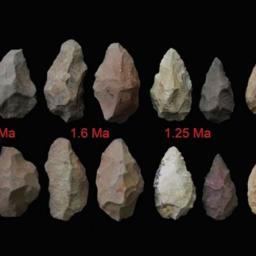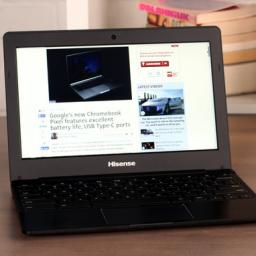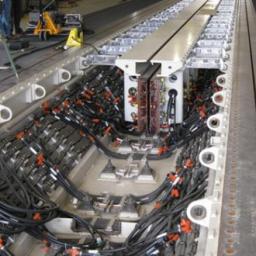
The oldest known stone tools in the world were made some 3.3 million years ago, which would make these newly discovered
implements older than modern humans. Archaeologists working in the Kenyan Rift Valley that discovered the tools said the set of 20 stone flakes and anvils are some 700,000 years older than stone tools from Ethiopia that previously held this record. These tools predate the earliest fossils representing our genus, Homo, by 500,000 years. What these tools suggest is that stone tool manufacture didn't begin with Homo as previously held but with a more primitive member of the human family.
Scientists working at the site of Dikika, Ethiopia in 2010 where fossils belonging to Lucy's species had previously turned up said they had recovered 3.4 million year-old animal bones bearing distinctive marks. They argued hominins had made the marks in the course of slicing meat off the bones with stone tools. The claim caused heated debate with some scientists saying the alleged cut marks were instead the result of the bones having been trampled by passing animals. Others suggested they were bite marks from crocodiles.
Worldwide, statistics show that crickets are the most widely cultivated insects for the human diet and are considered the "gateway bug" for people who choose to eat insects. Crickets are readily available in pet stores as food for turtles, frogs, and other pets. They are considered delicacies or snacks for people in many countries. Cricket flour is now commonly found in protein bars, baked goods, and protein powders. Crickets have been touted as much better for the planet-environmentally and financially-than livestock, due to the supposedly more-efficient rate at which they convert feed into body mass. But in reality,
there is very little data to support this.
Researchers measured the biomass output and feed conversion ratios of crickets (Acheta domesticus) that were reared on foods ranging from grain-based to high in cellulose. Crickets fed on processed food waste grew to harvestable size with conversion efficiency similar to industrial-scale production broiler chickens. But over 99 percent of the crickets fed minimally processed, municipal-scale food waste died before reaching a harvestable size. The measurements were made at a much greater population scale and density than any previously reported studies. These feed conversion ratios are much less efficient than those reported from studies conducted at smaller scales and lower population densities.
Astronomers are getting ready to do battle with the iRobot corporation over their new lawn mowing robots. The makers of the Roomba are working on a similar device used to mow lawns. Astronomers are
concerned about potential interference with radio telescopes. In February, iRobot filed a waiver request with the FCC to use part of the radio spectrum to guide the robots. The company wants to use the frequency band between 6240 and 6740 MHz, which is a frequency that several large radio telescopes use to observe methanol, which is plentiful in stellar nurseries.
iRobot has proposed adding a note to the user manual: "consumer use only; use must be limited to residential areas." The NRAO doesn't think the approach will work. Liszt and the NRAO say that they need a 55-mile exclusion zone to protect the data obtained by the radio telescopes. It is possible that the radio telescopes could begin generating bad data, without knowing why and without necessarily knowing that the data is bad, if the product goes ahead as planned.
Verizon Wireless said there are a handful of areas in which it had hoped to increase its spectrum holdings, but
will instead use small (or pico) cells to increase
frequency reuse on the network rather than simply using a larger block of spectrum. "We simply have to adjust our plans in certain places where we may have anticipated spectrum." New York and Boston are two markets in which Verizon Wireless did not acquire additional 1.7/2.1 GHz spectrum in the recent auction. Their budget for this year now includes an incremental $500 million for this kind of network densification.
Melone added that as the cost of spectrum has risen, the cost of
small cell technologies has been going down. "The comparison between the two changed dramatically," he said. Verizon also highlighted the improving economics of fiber as one of the reasons that small cells are becoming a more attractive investment.
This seems to support the
FCC's decades-old policy of using auctions as the most efficient way to allocate spectrum resources where they are most needed, in a simply supply & demand model. Never mind the substantial new source of income the US federal government has seen from the process.
The continent of Antarctica had its
hottest day ever in recorded history earlier this week, as temperatures soared to 63.5 degrees Fahrenheit (17.5 C) for the first time, eclipsing a record that's lasted over 50 years.
Base Esperanza, a research station run by Argentina situated on the northern tip of the Antarctic Peninsula, recorded the warm weather. The last time the region experienced such a high temperature was in April of 1961, when a high record of 62.7 degrees Fahrenheit was set at Base Marambio, another Argentinean base in the region. Scientists were particularly puzzled at the high temperature because it took place directly in the center of the autumn season for Antarctica. Base Esperanza typically experiences its hottest days in December with averages of around 37.8 degrees Fahrenheit. Normal March averages, in comparison, are closer to 31.1 degrees Fahrenheit (-0.5 C).

Google and its partners are preparing
a flood of new hardware to sway consumers away from cheap Windows laptops. Chromebooks from HiSense and Haier go on sale today for just $150 each. You also might consider the Asus Chromebit that will cost less than $100. The Chromebit looks very similar to the Chromecast, but runs a full Chrome-OS instance, on-a-stick, ready to plug into any monitor. "Think of a school lab, all the peripherals, but stuck to a desktop. Now you can replace that."
The secret behind these low-cost devices is
the RK3288, a very inexpensive quad-core Cortex-A12 ARM architecture processor, which was launched in mid-2014 from Rockchip, a Chinese chip maker that's little known outside of industry circles. Because the chip can draw as little as 3 watts of power, the Chromebooks based on it are designed without fans, and can last all day on a single charge. You also get 2GB of storage, and a 16GB SSD in all 3 devices.
With fewer than 25 million Chromebook sales last year (opposed to more than 302 million PC sales), Google still has work to do. And thus today's announcement. Google and its partners are lowering prices further while chasing the one commodity laptop users value most: battery life.

For almost as long as aircraft carriers have existed, they've been equipped with steam-powered catapults to help fighters and bombers get airborne. That's a remarkably old-fashioned technology when you're launching stealth fighters that cost upwards of $20 million each. Aircraft carriers are gigantic, but the runways simply aren't long enough for most planes to generate sufficient lift under their own power.
The US Navy is now testing a replacement system called the
Electromagnetic Aircraft Launch System (EMALS) aboard the new USS Gerald R. Ford. It works by using an electric current to generate magnetic fields that propel a carriage down the track built into the runway, launching planes much more smoothly and efficiently than the old steam catapults with improved reliability. A steam catapult takes up a great deal of space and weigh in excess of 1,300 pounds. These systems take a long time to recharge after each launch, and the launch itself is rather abrupt. There's no smooth acceleration with a steam piston, resulting in increase wear on the body of the aircraft. Steam catapults also use more power than the EMALS system.
Smartphone thefts are
down 40% in London, 22% in San Francisco and 16% in New York, while iPhone thefts are down even further, since the implementation of "kill switches," which allow owners to completely deactivate a phone that has been lost, making a stolen device worthless.
Major smartphone companies were reluctant. Gascon said he had met with Apple executives and been "rebuffed." Frankly, the carriers don't gain anything from this service, and
actually add customers when someone signs up with them using a stolen phone. As for the phone companies, every stolen phone is a potential new sale. Companies would never want to admit that stolen phones are good for their bottom line, but they don't have any good excuse for why they wouldn't voluntarily implement something. They only said that a kill switch had serious risks, including vulnerability to hackers who could disable others' phones. Meanwhile, Australian phone carriers have been doing it successfully since 2003.
"The significant decrease in smartphone thefts since the implementation of kill-switch technology is no coincidence," New York Police Commissioner William Bratton said in the press release. "Restricting the marketability of stolen cell phones and electronic devices has a direct correlation to a reduction of associated crimes and violence." Soon, all smartphones in the United States will have these features, as a California law passed in August will require all smartphones sold in the state to include kill switch technology, effectively requiring manufacturers to include the feature on all smartphones.
Scientists at the University of Florida have confirmed the Asian and Formosan subterranean termites - both formidable non-native species - are mating in south Florida. The offspring of these species thrive by combining the
strongest qualities of their parents. The two species are considered particularly damaging and difficult to control, since they travel underground and burrow up through buildings. What sort of termite do they produce? The bad news is that based on lab results, the hybrid colonies appear to grow faster than those of either species that produced them.
"The combination of genes between the two species results in highly vigorous hybridized colonies that can develop twice as fast as the two parental species," said Thomas Chouvenc, research assistant at the University of Florida's Subterranean Termite laboratory. "The establishment of hybrid termite populations is expected to result in dramatically increased damage to structures in the near future."
The annual cost of termite damage and control measures in the U.S. is estimated at $5 billion.
An easier to squeeze mayonnaise bottle might be
coming out this year, and easier to squeeze toothpaste could be here in 2017. This is thanks to a liquid-impregnated coating called LiquiGlide that can keep the inside of a container permanently wet and allow its contents to easily slide out. Elmers Products, Inc. is on board, too, and has already signed a contract with LiquiGlide to let you get every drop of glue out of the bottle. Follow the link for videos of the coating in action.
LiquiGlide is a liquid coating that binds much more strongly to textured surfaces than to liquids, so when it's painted onto the inside of a container, the liquid can flow freely over it without creating friction and viscosity. It was originally created in 2012 by a professor, Kripa Varanasi and his grad students at MIT. They've formed their own LiquiGlide company, and it's now getting some traction among consumer products. However, the original intent behind LiquiGlide was not to make it easier to have ketchup with your fries. Varanasi was thinking about industry applications like more efficient oil pumping. For now, the company has found success in consumer products, but it will continue pursuing industry application ideas too.
 The oldest known stone tools in the world were made some 3.3 million years ago, which would make these newly discovered implements older than modern humans. Archaeologists working in the Kenyan Rift Valley that discovered the tools said the set of 20 stone flakes and anvils are some 700,000 years older than stone tools from Ethiopia that previously held this record. These tools predate the earliest fossils representing our genus, Homo, by 500,000 years. What these tools suggest is that stone tool manufacture didn't begin with Homo as previously held but with a more primitive member of the human family.
The oldest known stone tools in the world were made some 3.3 million years ago, which would make these newly discovered implements older than modern humans. Archaeologists working in the Kenyan Rift Valley that discovered the tools said the set of 20 stone flakes and anvils are some 700,000 years older than stone tools from Ethiopia that previously held this record. These tools predate the earliest fossils representing our genus, Homo, by 500,000 years. What these tools suggest is that stone tool manufacture didn't begin with Homo as previously held but with a more primitive member of the human family.
